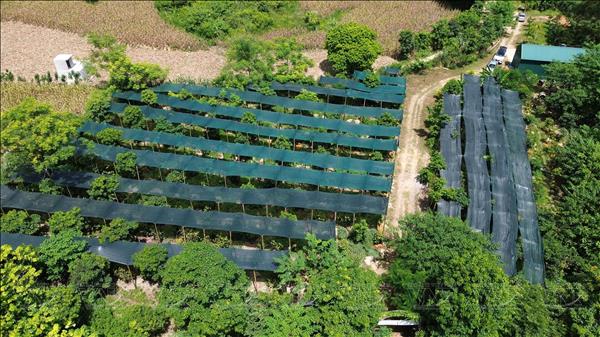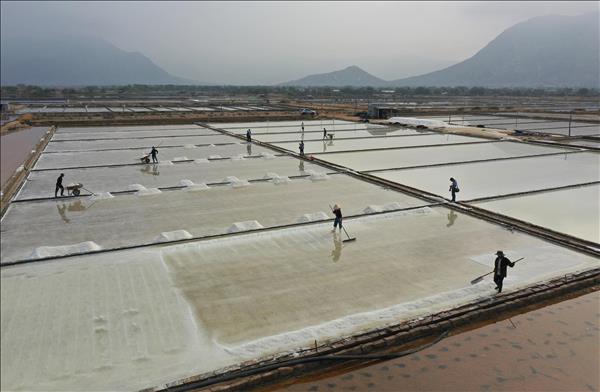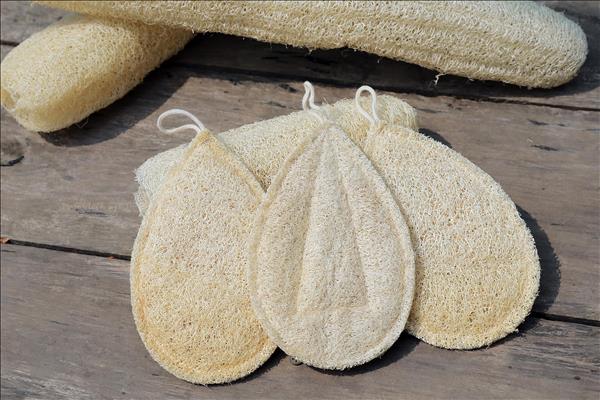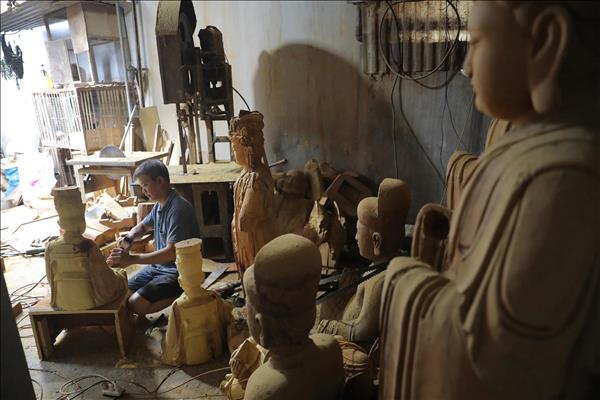Protecting the endangered sea cucumber
Regarded as a “miraculous drug” from the sea, sea cucumbers are not only used as food but also as medicine. The demand for sea cucumbers is so high that they are overcaught and are in danger of extinction.
Vietnam is among the countries that have access to this aquatic resource, particularly sandfish, which are found in river estuaries or gulfs with sandy bottoms. Because they live in large herds, the fish are easily found and thus overfished and exposed to the chance of extinction.
To conserve sandfish which is on the world’s red list of endangered species, the Research Institute for Aquaculture 3 (Institute 3) successfully studied the technology for breeding, production and commercial raising of sandfish in Nha Trang, Khanh Hoa, and coastal areas in southern central Vietnam. These are under two ministerial-level projects, according to Dr. Nguyen Dinh Quang Duy, deputy director of the National Center for Aquatic Breeds in the central region under Institute 3.
These two projects and other international cooperation projects on sandfish have helped shape and develop an aquaculture industry for this resource in Vietnam. In recent years, Institute 3 has cooperated with the Australian Center for International Agricultural Research (ACIAR) in projects to produce breeder sandfish and raise sea cucumbers in combination with shrimp or sweet snails.
With technical support from these projects, many fish farmers have shifted from raising shrimp, sweet snails and fish, to cultivating breeder sandfish which helps them earn more money.
Dong Van Hai in Van Hung commune, Van Ninh district, received assistance from technicians of the National Center for Aquatic Breeds in cultivating sea cucumbers, sweet snails and seaweed in the same pond. Hai said that this combined production has proved to be more efficient economically.
The price of a breeder sandfish ranges from 3,000-10,000 dong (1.3-4.3 US dollars) depending on its type and size. The time to raise sandfish lasts between 10-12 months. At harvest time, each sand fish weighs between 250-330 grams.
The raising of sea cucumbers on an industrial scale helps develop the breeder production and commercial rearing of an aquatic species of high economic value. It also creates jobs for people, especially women, in island and coastal areas.
Multilateral cooperation in breeder giant grouper production
Scientists of Institute 3 have successfully produced giant grouper breeds and hybrids between giant groupers and tiger groupers. The breeding of these fish with a high economic value has opened up opportunities for sustainable grouper aquaculture.
Dr. Truong Quoc Thai, director of the Aquaculture Research and Development Center in Nha Trang, said that Vietnam, like many countries, prioritized the raising of giant grouper because of its fast growth and high economic value. But the country had no commercial breeder production establishment because it lacked knowledge about the species’ maturation and spawning behavior, and thus few larvae survived.
The project “Developing technologies for giant grouper aquaculture in Vietnam, the Philippines and Australia” which was implemented from January 1, 2014 to December 31, 2018, solved this problem by tapping resources through multilateral cooperation. The project was funded by ACIAR and headed by Dr. Abigail Alizur from the University of the Sunshine Coast, Australia. Dr. Nguyen Huu Ninh from Institute 3, and Dr. Felix Ayson from the Southeast Asian Fisheries Development Center, were the project coordinators in Vietnam and the Philippines.
Head of the project in Vietnam, Dr. Truong Quoc Thai, said that the project aimed to develop giant grouper aquaculture in three countries, but the implementation differed from one country to another, depending on their advantages. In Vietnam and the Philippines which had the advantages for raising fish, the project focused on developing the technology for incubating, spawning, and fish larvae rearing.
The project assisted the center to collect and cultivate a herd of 16 adult giant groupers in 2016. This herd is now developing and the groupers are breeding to hatch eggs.
“With the support from ACIAR, the center has developed a system of breeder fish incubation to produce quality breeders,” Thai said, adding that his center is now a major supplier of giant grouper larvae for breeder production establishments nationwide.
The center has developed a process for producing giant grouper breeds. In 2018, it produced 80,000 quality breeder giant groupers which were sold with a price subsidy to farmers in and outside Khanh Hoa.
Regarded as a “miraculous drug” from the sea, sea cucumbers are not only used as food but also as medicine. The demand for sea cucumbers is so high that they are overcaught and are in danger of extinction.
Vietnam is among the countries that have access to this aquatic resource, particularly sandfish, which are found in river estuaries or gulfs with sandy bottoms. Because they live in large herds, the fish are easily found and thus overfished and exposed to the chance of extinction.
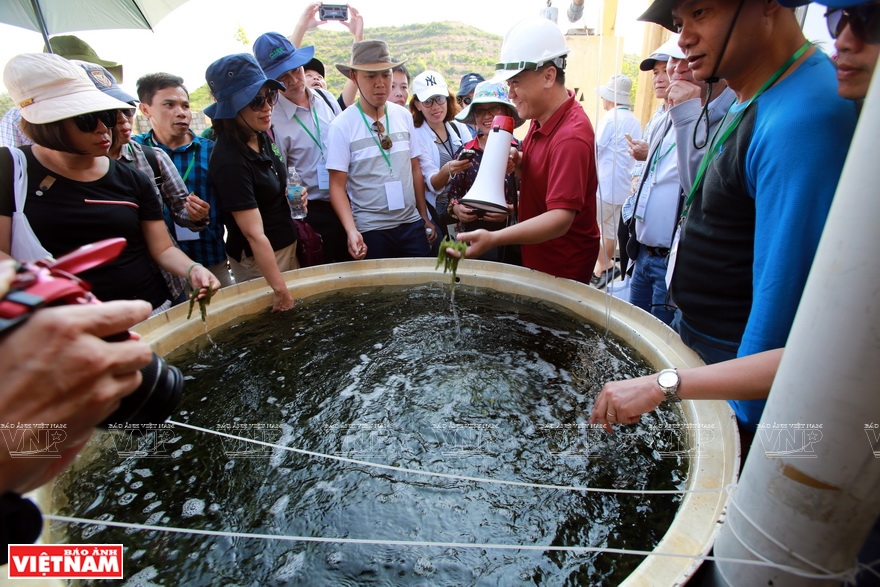 Dr. Nguyen Dinh Quang Duy (holding the loudspeaker) introduces to ACIAR’s partners in Vietnam, a tank for cultivating sea grapes, a type of seaweed raised together with sea cucumbers.  Apart from its commercial value, sea grapes, when cultivated with sea cucumbers, are regarded as a “biofilter” which helps improve the water’s environment. 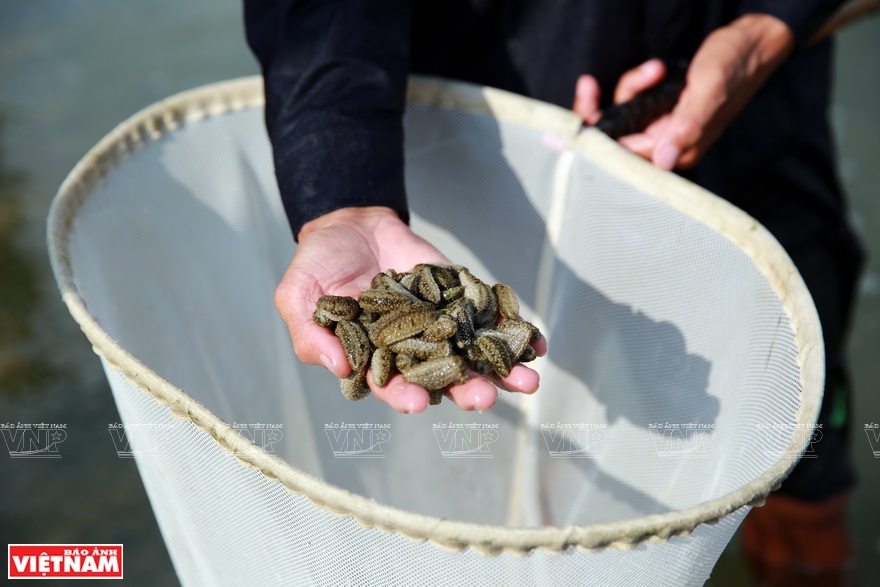 The toughest job in raising sandfish is producing the breeders, which lasts from 3-4 months.  A pond which combines the raising of sea cucumbers and sweet snails in an experimental area in Van Ninh district, Khanh Hoa. 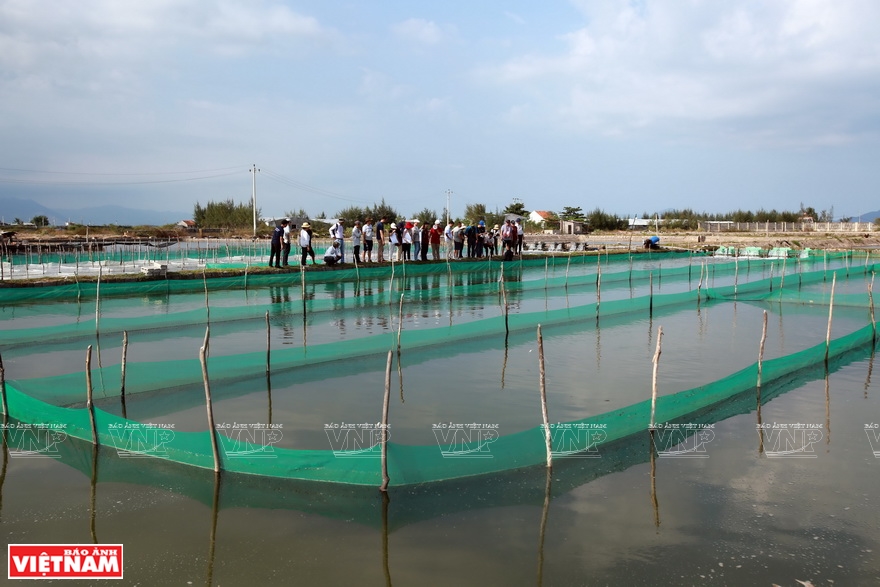 Agricultural experts, researchers and administrators pay a field visit to an ACIAR-funded project headed by Dr. Nguyen Dinh Quang Duy. 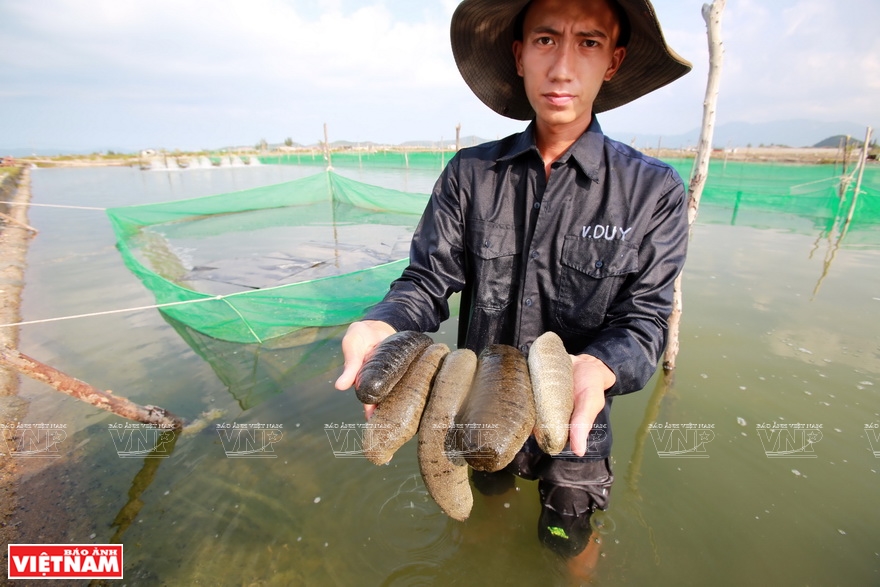 After over a year, the harvested sand fish weigh an average of 330 grams. |
To conserve sandfish which is on the world’s red list of endangered species, the Research Institute for Aquaculture 3 (Institute 3) successfully studied the technology for breeding, production and commercial raising of sandfish in Nha Trang, Khanh Hoa, and coastal areas in southern central Vietnam. These are under two ministerial-level projects, according to Dr. Nguyen Dinh Quang Duy, deputy director of the National Center for Aquatic Breeds in the central region under Institute 3.
| In 2015, the world’s total output of sandfish reached 156 tons, worth 732,000 US dollars, most of which were produced in Vietnam and Malaysia. |
With technical support from these projects, many fish farmers have shifted from raising shrimp, sweet snails and fish, to cultivating breeder sandfish which helps them earn more money.
Dong Van Hai in Van Hung commune, Van Ninh district, received assistance from technicians of the National Center for Aquatic Breeds in cultivating sea cucumbers, sweet snails and seaweed in the same pond. Hai said that this combined production has proved to be more efficient economically.
The price of a breeder sandfish ranges from 3,000-10,000 dong (1.3-4.3 US dollars) depending on its type and size. The time to raise sandfish lasts between 10-12 months. At harvest time, each sand fish weighs between 250-330 grams.
The raising of sea cucumbers on an industrial scale helps develop the breeder production and commercial rearing of an aquatic species of high economic value. It also creates jobs for people, especially women, in island and coastal areas.
Multilateral cooperation in breeder giant grouper production
Scientists of Institute 3 have successfully produced giant grouper breeds and hybrids between giant groupers and tiger groupers. The breeding of these fish with a high economic value has opened up opportunities for sustainable grouper aquaculture.
Dr. Truong Quoc Thai, director of the Aquaculture Research and Development Center in Nha Trang, said that Vietnam, like many countries, prioritized the raising of giant grouper because of its fast growth and high economic value. But the country had no commercial breeder production establishment because it lacked knowledge about the species’ maturation and spawning behavior, and thus few larvae survived.
The project “Developing technologies for giant grouper aquaculture in Vietnam, the Philippines and Australia” which was implemented from January 1, 2014 to December 31, 2018, solved this problem by tapping resources through multilateral cooperation. The project was funded by ACIAR and headed by Dr. Abigail Alizur from the University of the Sunshine Coast, Australia. Dr. Nguyen Huu Ninh from Institute 3, and Dr. Felix Ayson from the Southeast Asian Fisheries Development Center, were the project coordinators in Vietnam and the Philippines.
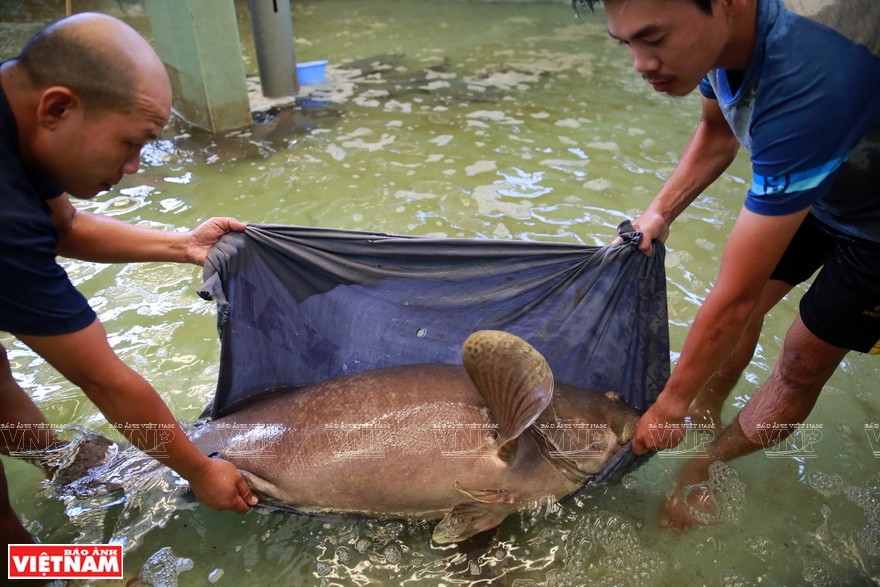 A technician checks the sperm of an adult grouper at the Aquaculture Research and Development Center in Nha Trang. 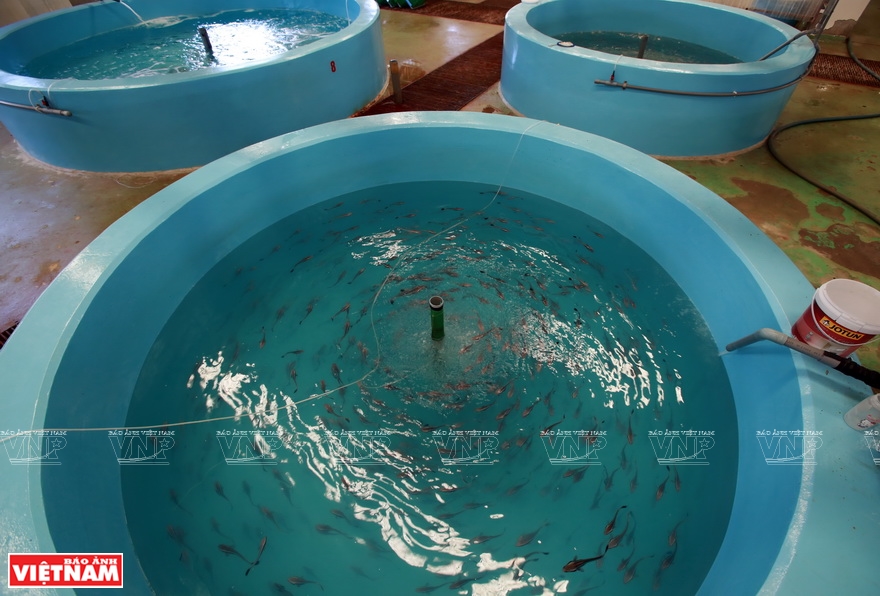 A modern system for cultivating breeder fish. 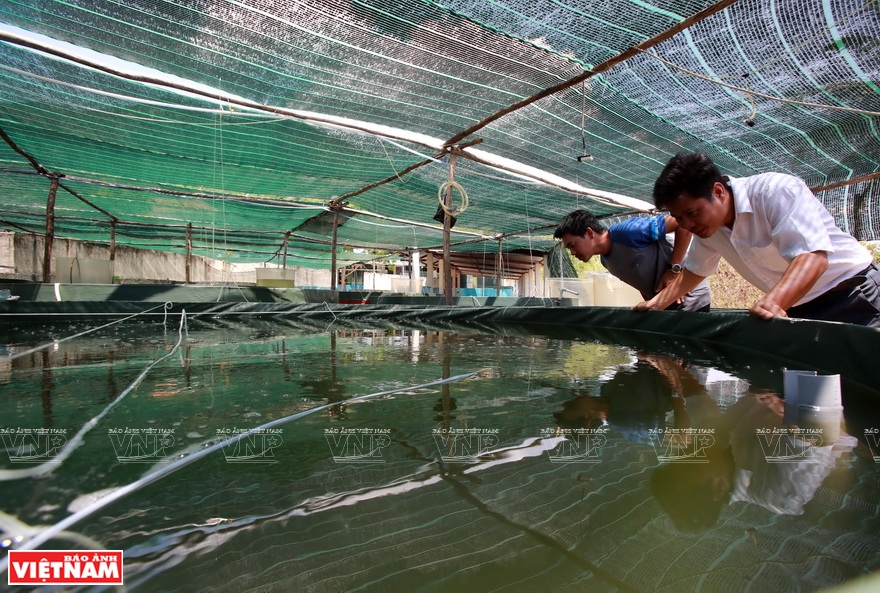 Dr. Truong Quoc Thai and his colleague check a tank for giant grouper larvae rearing. 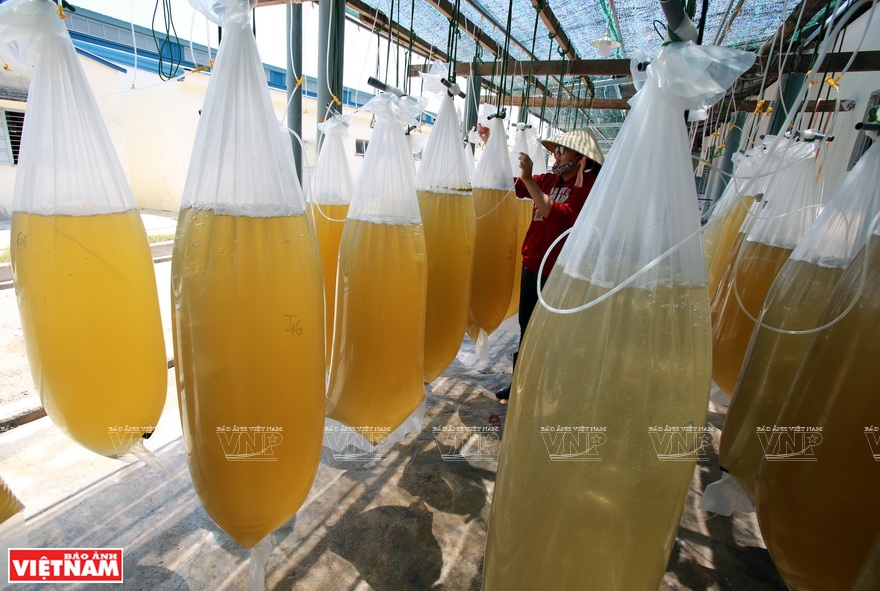 Transplanting seaweed as food for breeder fish at the Aquaculture Research and Development Center in Nha Trang.  A type of hybrid grouper which can grow fast in a severe living environment. |
Head of the project in Vietnam, Dr. Truong Quoc Thai, said that the project aimed to develop giant grouper aquaculture in three countries, but the implementation differed from one country to another, depending on their advantages. In Vietnam and the Philippines which had the advantages for raising fish, the project focused on developing the technology for incubating, spawning, and fish larvae rearing.
| Khanh Hoa is home to Nha Trang, Cam Ranh and Van Phong bays with a total area of over 100,000 ha. The natural and hydrometeorological conditions here are favorable for mariculture, especially for the lobster and fish, including giant grouper. |
“With the support from ACIAR, the center has developed a system of breeder fish incubation to produce quality breeders,” Thai said, adding that his center is now a major supplier of giant grouper larvae for breeder production establishments nationwide.
The center has developed a process for producing giant grouper breeds. In 2018, it produced 80,000 quality breeder giant groupers which were sold with a price subsidy to farmers in and outside Khanh Hoa.
By Trong Chinh

